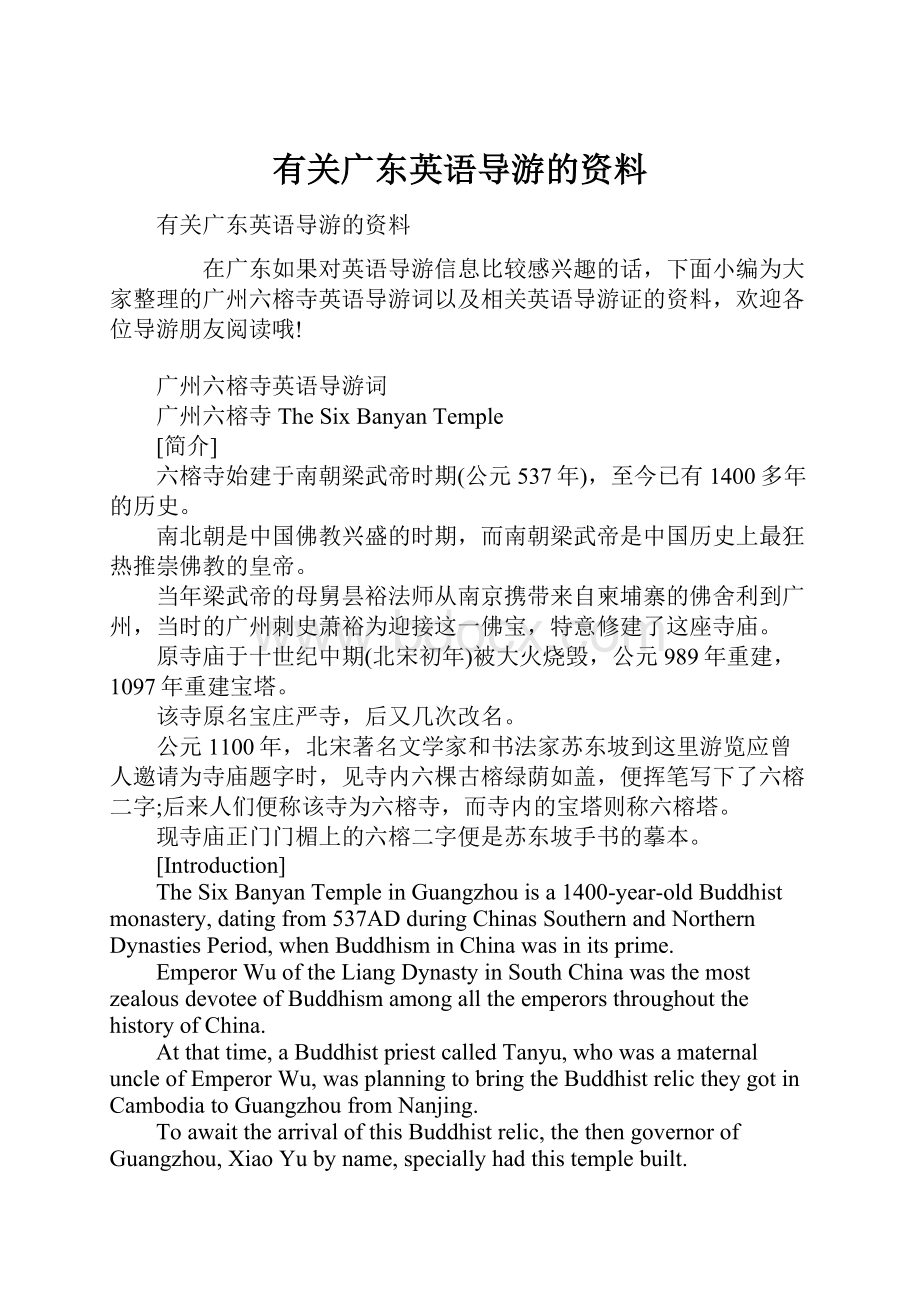有关广东英语导游的资料.docx
《有关广东英语导游的资料.docx》由会员分享,可在线阅读,更多相关《有关广东英语导游的资料.docx(8页珍藏版)》请在冰豆网上搜索。

有关广东英语导游的资料
有关广东英语导游的资料
在广东如果对英语导游信息比较感兴趣的话,下面小编为大家整理的广州六榕寺英语导游词以及相关英语导游证的资料,欢迎各位导游朋友阅读哦!
广州六榕寺英语导游词
广州六榕寺TheSixBanyanTemple
[简介]
六榕寺始建于南朝梁武帝时期(公元537年),至今已有1400多年的历史。
南北朝是中国佛教兴盛的时期,而南朝梁武帝是中国历史上最狂热推崇佛教的皇帝。
当年梁武帝的母舅昙裕法师从南京携带来自柬埔寨的佛舍利到广州,当时的广州刺史萧裕为迎接这一佛宝,特意修建了这座寺庙。
原寺庙于十世纪中期(北宋初年)被大火烧毁,公元989年重建,1097年重建宝塔。
该寺原名宝庄严寺,后又几次改名。
公元1100年,北宋著名文学家和书法家苏东坡到这里游览应曾人邀请为寺庙题字时,见寺内六棵古榕绿荫如盖,便挥笔写下了六榕二字;后来人们便称该寺为六榕寺,而寺内的宝塔则称六榕塔。
现寺庙正门门楣上的六榕二字便是苏东坡手书的摹本。
[Introduction]
TheSixBanyanTempleinGuangzhouisa1400-year-oldBuddhistmonastery,datingfrom537ADduringChinasSouthernandNorthernDynastiesPeriod,whenBuddhisminChinawasinitsprime.
EmperorWuoftheLiangDynastyinSouthChinawasthemostzealousdevoteeofBuddhismamongalltheemperorsthroughoutthehistoryofChina.
Atthattime,aBuddhistpriestcalledTanyu,whowasamaternaluncleofEmperorWu,wasplanningtobringtheBuddhistrelictheygotinCambodiatoGuangzhoufromNanjing.
ToawaitthearrivalofthisBuddhistrelic,thethengovernorofGuangzhou,XiaoYubyname,speciallyhadthistemplebuilt.
Theoriginalstructureofthetemplewasdestroyedbyfireinthemiddleofthe10thcenturyduringtheearlyyearsoftheNorthernSongDynasty.
Theexistingtemplewasbuiltin989andthepagodawasreconstructedin1097.
Thistemplehasgotdifferentnames.
In1100,whenSuDongpo,acelebratedwriterandcalligrapheroftheNorthernSongDynasty,cametovisitthetempleandwasaskedtoleaveapieceofhiscalligraphyinthetemple,hewrotedowntwoChinesecharactersLiuRong,meaningSixBanyaninEnglish,becausehewasdeeplyimpressedbythesixbanyantreesthengrowinginthetemple.
SincethenthetemplehasbeencommonlyknownastheSixBanyanTempleandthepagoda,theSixBanyanPagoda.
Nowthefacsimilesofthesetwocharacterscanstillbeseenengravedonthestonetabletinacorridorandontheslaboverthelintelofthefrontdoor.
[天王殿]
寺庙进门处为天王殿,正中的佛像是弥勒佛,又称笑佛;据说他是释迦牟尼的候补佛,故又称未来佛。
两边的对联(大腹能容容天下难容之事,张口而笑笑天下可笑之人)是人们对弥勒佛的颂扬之词。
两则的塑像是东西南北四方守护神,他们手中各持一法宝(剑、琵琶、雨伞和地龙),寓意风调雨顺。
弥勒佛后面的塑像是寺庙的守护神,叫韦驮;他是四大天王手下32将之首。
[TheHallofHeavenlyKings]
TheentrancehallofthetempleiscalledTheHallofHeavenlyKingsandistheshrineforMileBuddha(Maitreya)andtheHeavenlyKings(ortheDivasasarecalledinBuddhistsutra).
Thestatueinthemiddle,themanwithabigbelly,isMileBuddha,whoiscommonlyknownastheLaughingBuddhabecauseheisalwaysgrinningfromeartoear.
HeisthefuturesaviorthatwilldeliveralllivingbeingstotheBuddhistparadiseafterSakyamunisBuddhistpowerisexhausted,andsoheisalsoknownastheFutureBuddha.
ThecoupletonbothsidesisacomplimenttotheLaughingBuddha,meaningliterally:
Abigbellycanholdtheworldstroublesthataretroublingpeople.
Anopenmouthissmilingatthosewhoaretobesmiledat
Oneithersideofthehallwecanseetwostatues.
TheyarethefourHeavenlyKings,whoareprotectorsofBuddhistdoctrines,witheachtakingcareofoneside-theeast,west,northandsouth.
Itistheirjointeffortsthatensureharmony,peaceandprosperityoftheworld.
Thefourobjectstheyareholding-apipa(aChinesepluckinstrument),anumbrella,asnakeandasword-combinetomeanthatBuddhawillensureafavorableweatherforthecropssothatpeoplemayliveahappylife.
(Individually,theoneplayingapipatakeschargeoftheaffairsintheEastandisassociatedwithharmony,asareallmusicians;theoneholdinganumbrella,whichisasymbolofrainthatnourishesthecrops,isinchargeofthenorthernaffairs;thethirdprotectorholdingasnakeinhishandtakeschargeoftheaffairsintheWestandisbelievedtobeabletotameallevil-doersandkeepthemundercontrol;theswordcarrier,wholooksafterthesouthernaffairs,issupposedtobeabletobringwind.)
StatueatthebackoftheLaughingBuddhaisthepatronofthetemple,WeiTuoorVedabyname,whoisnumberoneamongthe32generalsunderthefourHeavenlyKings.
[六榕塔]
六榕塔是寺庙的舍利塔。
据记载,塔的地基下埋藏着佛牙舍利、宝剑和铜鼎等佛宝。
因该塔外表华丽,就像花朵叠成的一根花柱,故又称花塔。
此塔呈八角形,高57米,外观九层,里面实际有17层,有楼梯通达塔顶;外层各个方向均有入口进入塔内,但每层只有一个入口可通向楼梯,故游客上下时须沿外层转圈寻找楼梯入口。
搭的顶部有一铜质塔刹,1358年铸造,上面铸有1023尊佛像。
故千佛铜铸连同其它铜饰重量超过5吨。
[TheSixBanyanPagoda]
TheSixBanyanPagodawasbuiltforkeepingBuddhistrelics.
Accordingtotherecords,someholyashesfromBuddhasteeth,asword,abronzetripodandsomeotherBuddhisttreasuresareburiedunderthefoundationofthepagoda.
Thisoctagonalmagnificentpagoda,withitsblueglazedtiles,vermilionbeams,paintedwallsandredpillarsallingoodmatch,lookslikeaflowerycolumnandsoitisoftenreferredtoastheFloweryPagoda.
Thehighlightofthevisittothetempleistoclimbthepagoda.
This57-meter-highpagodalookstohaveonly9storiesontheoutsidebutactuallyhas17storiesinside.
Oneachofthe9externalfloors,therearemanyentrancesleadingtoitsinteriorbutonlyoneisaccessibletothestaircase.
So,ifyouloseyourway,youjustturnaroundthecircleandyouwillfindyourwayupordown!
Onthetopfloor,thereisahugebronzecolumnwith1023Buddhafigurinesinrelief.
Castin1358,thisbronzecolumn,togetherwithitsattachments,weighsover5tons.
[大雄宝殿]
六榕塔的西面是寺庙的主殿大雄宝殿;里面供奉的是释迦牟尼、阿弥陀佛和药师佛;他们是现在世、东方净琉璃世界和西方极乐世界的教主,称三世佛(他们是代表中,东,西三方不同世界的佛)。
这三座铜佛像于1663年铸造,高6米,每尊重10吨,是广东省内最大的铜佛像。
这三尊佛像原供奉在广州惠福西路的大佛寺;文化大革命时红卫兵破四旧把佛像清出大佛寺,放进了废品仓库里,1983年六榕寺重建大雄宝殿时把他们供奉在这里。
[TheSakyamuniHall]
Tothewestofthepagodaisthemainhallofthetemple-theSakaymuniHall.
Inthishall,thestatuesofSakyamuniBuddha,AmidaBuddhaandthePharmacistBuddha(Bhaisajya-guru)areenshrined.
TheyarethethreemasterBuddhasofthecentral,westernandeasternworlds.
ThesethreebronzeBuddhastatues,all6metershighandeachweighing10tons,werecastin1663andarethebiggestbronzeBuddhastatuesinGuangdongProvince.
OriginallytheyweresettledintheBigBuddhaTempleatHuifuXiRoadinGuangzhou.
Inthe1960sduringtheCulturalRevolution,theywereregardedasvestigesoftheoldfeudalideasandweremovedoutofthetempleandputintoascrapwarehousebytherebelliousRedGuards.
In1983,theywereremovedtobemountedherewhentheSakyamuniHalloftheSixBanyanTemplewasrebuilt.
[六祖堂]
六榕塔南面的殿堂叫六祖堂;里面供奉的是中国佛教主要流派禅宗的第六祖惠能;他是南派禅宗的创始人。
传统佛教认为:
世间的一切都有是苦,要摆脱六道轮回的苦果,只有排除产生烦恼的欲望,使自己达到一种寂灭为乐的涅槃境界;而要达到这种境界,就必须按照八正道进行修炼。
慧能在如何修炼成正果这个问题上进行了改革创新。
他抛弃了繁琐的修炼程序,认为人人皆有佛性,任何人(包括天天杀生的屠夫)只要用简单的方法,即通过坐禅就能明心见性,见性成佛;所谓放下屠刀,立地成佛。
这是南派禅宗创始人慧能的基本佛理。
(有关慧能及其佛理参见南华寺篇)
[TheSixthPatriarchHall]
TothesouthofthepagodaistheshrineforworshipingHuiNengwhowastheSixPatriarchofChanBuddhismandfounderofthesouthsectofChanBuddhism,whichistheprevailingBuddhistsectinChina.
(SeeNanhuaTempleformoredetailsaboutHuiNeng)
WhatandhowisthesouthsectofChanBuddhism?
Well,accordingtoBuddhistdogmas,sufferingsandmiseriesexisteverywhereinthisworldandevilsarecausedbypeoplesdesireandattachment.
Andlife,aswellastime,iscyclicalandallbeingsaresubjecttothesufferingsofchangesindifferentincarnations.
Thesoulmayenduremanylivesbuttheconditionofthenewlifedependsonthebehaviorofthesoulinitspreviousbody.
Ifanindividualignoresopportunitiesforrightthinkingandrightaction,initsnextlifeitwillhavetopayforitspastmistake.
Therefore,inordertoescapethewheeloflifeandtoescapefromsufferingandmisery,humanbeingsmusteliminatealldesireandattachment,suchasthoseformoneyandsex,whicharethecausesofallevils.
ThewaytoachievethegoalofeliminatingdesireandattachmentmaydifferwithdifferentsectsofBuddhism.
HuiNeng,thesixthpatriarchofChanBuddhism,madethisverysimple.
Hediscardedalltheredtapesandadvocatedthat,toachievethisgoal,oneshouldonlypracticeumbilicalcontemplation,thatis,torestrainoneselffromanydesireandemotionsbyquietlysittingcross-leggedtoconcentrateonesmindontheumbilicusofonesown,inaposturelikethatofhisstatueyoucanseeinthetemple.
ThesouthsectChanBuddhistsbelievethateverybodyhasaninherentBuddhistnature,thatis,apeacefulandundistractedstateofmindthatwasoriginallyfreefromevilintentionandanxiety.
ThisBuddhistnatureinhisownmindcanberealizedaslongashegivesupalldesireandattachmentand,oncehehascometorealizeit,hewillinstantlybecomeaBuddha.
And,evenabutcherwhousedtokilllivingbeingseverydaycanbecomeaBuddhaaslongashedropshiscleaverandpracticecontemplationtorealizehisBuddhistnature.
广东英语导游证相关资料
本人在2012年11月10日结束了广东英语导游证的口语部分,由于考前在网上查不到很多关于英语导游证的信息,导致我对考试形式、考试内容不太清楚,因此想分享本次考证经验,供大家参考。
导游证分为笔试和口试两部分,先考笔试,一个多月后考笔试。
导游证也分为中文导游证和外语导游证(英语、日语、泰语等)。
无论哪种语种,笔试都是中文,而口试就是相应的语种。
关于,导游证的报名方式、报名时间、费用等问题,可以浏览活力广东网()的政务公告栏或登陆湛江旅游网
这次,我主要想分享的是英语导游证的口试环节。
口试考试流程:
(总分200)
1、广东概况、景点介绍;(60分)
2、中外互译;(20分)
3、导游规范服务知识题;(15分)
4、特殊问题的应变处理技巧题;(15分)
5、短文复述;(20分)
除此之外,还有语音60分(包括:
语音语调、语法、表达、听力),仪态气质10分。
1.广东概况、景点介绍
在我们报名时,可以在报名处买一本《广东英语导游》,书内就有广东概况和25处广东的景点介绍(英文版及其翻译)。
另外景点介绍在报名时,考试单位已经确定的考试范围。
所谓的考试范围就是,在25处景点介绍中选四篇,备考口试就不需要25处全背,只背其中四篇就可以的。
(其实那也够多了。
)这次规定的就是广州黄埔军校旧址、潮州开元寺、中国民俗文化村、肇庆七星岩(四个景点根据抽签考其中一个)。
这次口试,在景点介绍那部分,我手气不错,抽到了肇庆七星岩,是我最熟悉的一篇了。
我信心满满的展示,考官看见了,仅让我背完generalintroduction,就打断了我,让我跳到另一个景点,这是我在平时练习没有练过的,然后思维得马上跳跃,这也是缺乏考试经验的原因。
而广东概括就更简单了,书上慢慢的两千多字我都乖乖背熟,考官只是残酷的问了两个问题。
所以再强调,知道怎么考,复习效率可能更高。
但是,背了也有很多很多好处,比如了解广东概况还有一些表达。
我对自己这部分的表现还是挺满意哒。
2.中外互译
在考口试前,我以为中外互译和短文复